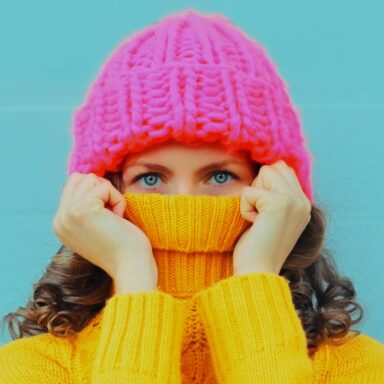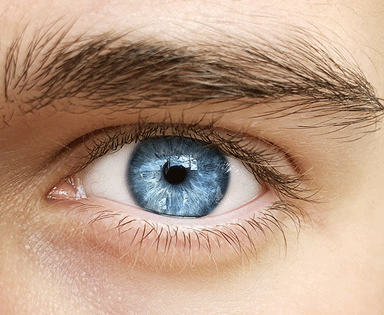How to look after your eyes this Christmas and other tips for the festive period
Posted on 14 November 2022
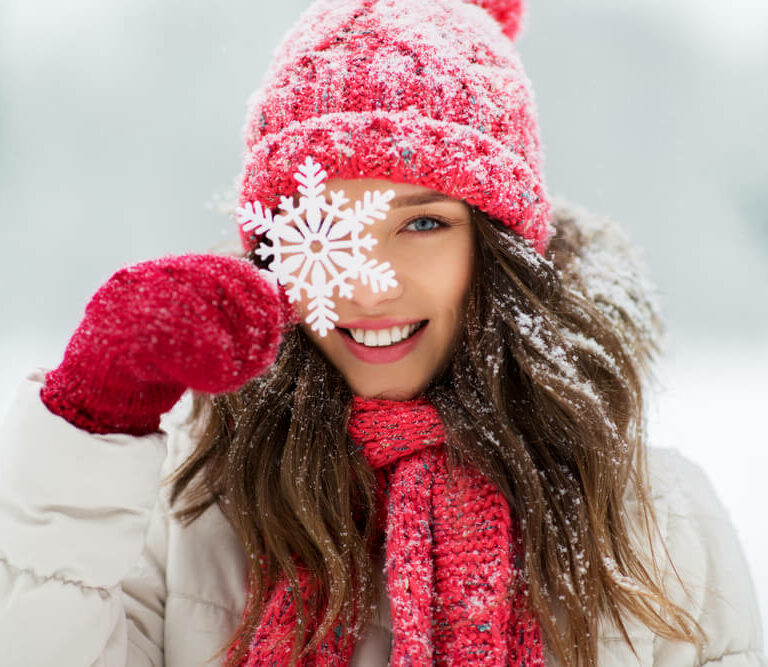
Fab food, gorgeous gifts and dazzling decorations – it’s no wonder that Christmas is the most wonderful time of the year.
Don’t let eye problems spoil your fun! We’ve put together a few elf ‘n’ safety tips to help keep your eyes healthy this Christmas.
Read on too, for our festive take on Santa’s eye health – including why he might be helping himself to some of Rudolph’s carrots.
Ho ho ho!
Are LED Christmas lights bad for your eyes?
There’s nothing like switching on the lights on your tree to make you feel all Christmassy.
Whether they are arranged just-so or all higgledy-piggledy, Christmas wouldn’t be Christmas without them.
But are they bad for your eyes?
Well, the blue light produced by LED lights (your Christmas tree lights will likely be LED, unless they are old ones you’ve had for ages) has been linked to eye problems.
One study warned that long-term exposure to LED lights can speed up ageing of the retina, the delicate light-sensitive layer at the back of your eyes.
The French government scientists behind the report said this could raise the risk of age-related macular degeneration – that’s when the middle part of your vision becomes blurry.
But before you ditch your fairy lights, it’s worth noting that by long-term, the researchers meant several years – that’s a lot of looking at your tree! 1 And overall, there just isn’t enough evidence to recommend against LED lights.2
If you find that your Christmas tree lights are hurting your eyes though, you could try dimmable versions, to see if they are kinder to your eyes. Or swap lights that flash and flicker for ones that give off a steady glow.
Christmas dinner: is it good for your eye health?
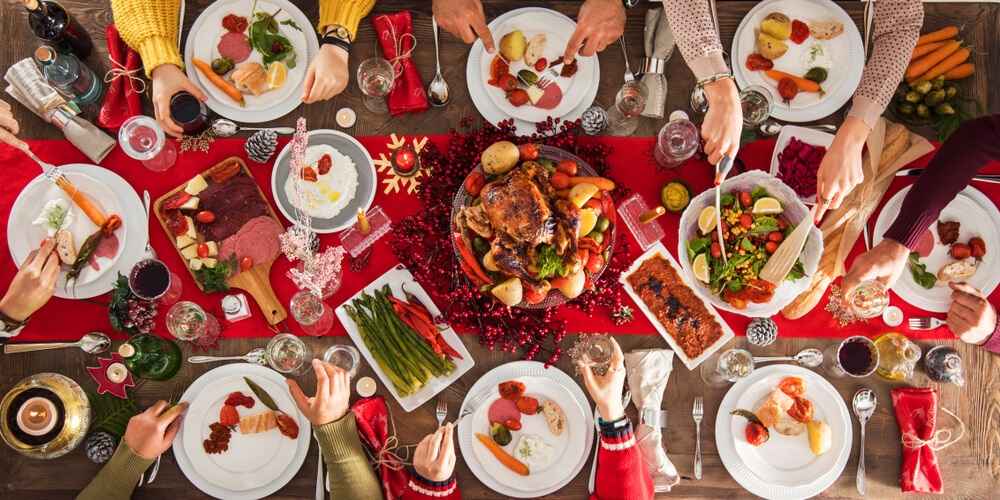
Christmas dinner isn’t just a time for tucking into some of your favourite food, telling (bad) cracker jokes and, dare we say it, over-eating. It’s also a time for feasting on eye-friendly foods, in fact, you’ll likely be doing it without knowing it.
- Turkey’s rich in zinc, which is good for the retina. Oysters are high in zinc too.3
- The omega-3 fats in salmon might be good for dry eye3
- Carrots are bursting with healthy vitamin A and broccoli is high in the minerals lutein and zeaxanthin, all of which help nourish our eyes.3 You can get lutein from cranberries, too4
- Some nuts and seeds, such as almonds and sunflower seeds, are good sources of eye-health friendly vitamin E.3
- Chocolate, dark chocolate to be precise, may give vision a boost by improving visual clearness and contrast sensitivity (the ability to tell apart an object and its background).5
PS If there’s an orange in your Christmas stocking, enjoy! Oranges are packed with vitamin C, which helps keep our eyes healthy.3
The festive foods to go easy on
But before you get carried away, there are some foods that it’s best to avoid – or at least not eat loads of.
These include:6
- White bread and pasta – they’ve been linked to age-related macular degeneration.
- Bacon and other processed meat. The salt in them can raise the risk of several different eye problems, so perhaps take it easy on the pigs in blankets!
Ready-made food that’s high in salt. Keep any eye out for low salt versions and add some herbs & spices, if you need a flavour boost.
Sugary drinks, including energy drinks. Lots of sugar can up your odds of type 2 diabetes and heart disease – and the eye conditions that can come with them.
What about alcohol?
It’s easy to over-indulge at Christmas but too much alcohol can cause eye problems from blurry vision to seeing double7 and annoying eye twitches8. Too much alcohol can also raise the risk of dry eyes.9

Drinking a little now and again, though, may mean you are less likely to need to have surgery for cataracts – the clouding over of the eye’s lens that happens as we get older. Red wine seems to be particularly good at keeping cataracts away.10
Watch out for the most common eye injuries over Christmas
Help keep your – and your children’s – eyes safe from hazards from Christmas tree branches to champagne corks by following these tips:
Christmas tree and decorations
Keep an eye out for stray branches when carrying your tree home – and trim back any low branches that could poke children in the eye when they are reaching under the tree for their presents.
Mind your eyes when leaning over the tree to decorate it too (particularly if you’ve had a glass or two of mulled wine) and hang any sharp or pointy ornaments out of children’s reach.11,12

Toys
To cut the chance of toy-related eye injuries, follow the age recommendations on toys, even if your child is super bright. The age-limit advice is based on kids’ development at a given age – not how brainy they are.12
Remember that some of the most fun toys, such as remote control helicopters, have the potential to damage the eyes.13
Laser pens and pointers can cause blindness if shone directly in the eyes and shouldn’t be given to kids as presents.14,15
Tell children not to aim at the face when firing foam darts. These can cause serious eye injuries, despite being soft, and children should always be supervised when playing with them.12
Champagne corks
Think before you pop! A champagne cork can shoot out at nearly 50mph, so take a few seconds to aim the bottle away from your and other people’s eyes before you crack open the fizz.12
The same applies to party poppers – they should also pointed away from people’s faces.11
Christmas eye make-up tips
Christmas is a time to sparkle – and, for lots of us, that means glittery eye make-up.
If it gets into your eye though, glitter can cause irritation and, in some cases, infections and other problems.
For instance, glittery make-up can raise the risk of dry eye – like the name suggests, that’s when the eyes are drier than they should be – or make it worse. That’s because the glitter can clog up tiny glands that help make the tears that keep our eyes nice and moist.16
Friends star Jennifer Aniston has dry eye and has said that glittery eye shadow is a no-no for her.17
If you can’t bear to give up your glitter, though, it’s best to stick to products that are specifically made for the eyes. That means not using craft glitter as make-up and avoiding craft glue too. (If you need to glue on your eye glitter, stick to eyelash glue and other eye-safe adhesives.)18
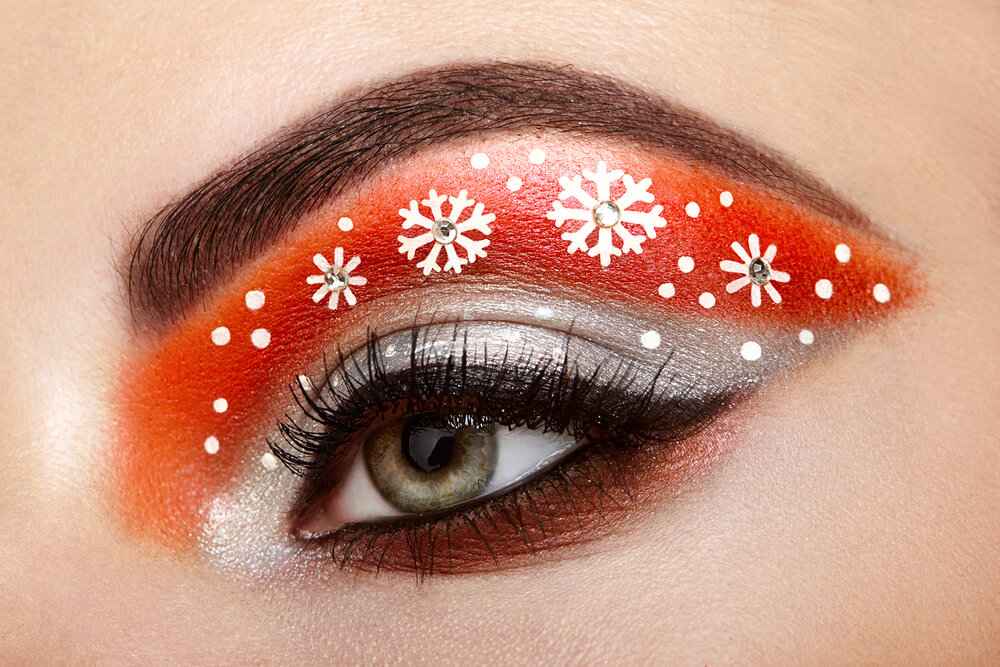
Other tips to keep your eyes sparkling safely at Christmas include:
- Don’t share make-up with others. It can be tempting to swap products when getting ready to out together, or when you meet up in the loos, but its best to stick to your own to cut the risk of infections such as conjunctivitis.19
- Keep completely still when applying false eyelashes. This means not putting them on in the car, Tube or anywhere else where you might get bumped or jostled.20
- To keep blepharitis in check, don’t apply eyeliner behind your lashes.21
- Put make-up on your Christmas present list. Experts recommend we treat ourselves to new make-up every six months or so, to keep bacteria at bay.22
- Remember to take all your make up off at night – including every tiny bit of your glittery eyeshadow.23
Did you know?
Christmas eye disease is a thing and it’s a lot less fun than its name suggests. It affects the cornea, the eye’s clear outer layer, and can be extremely painful. Thought to be caused by a chemical released by a beetle when crushed, it only occurs in Australia, is seasonal and, thankfully, most people make a full recovery.24,25
Should you do your LASIK eye surgery in the winter?
Are you thinking about having LASIK over the festive period? This very popular laser eye surgery can correct long and short-sightedness and astigmatism, a condition that makes vision blurry, too.26 No doubt you will have lots of questions, including whether Christmas is the best time to have it.
There are definitely some pluses to having it done over the festive period.
You can put your feet up
It might be easier to take a bit of time off work to rest up after the procedure then than at other times of the year.
You will be all set for the summer
It’s not just about work, though. You’ll probably be told to avoid contact sports and swimming for the first few weeks,27 so if your summer is all about getting on the tennis court, playing football and having dips in the sea, winter may be a better time for your LASIK.
LASIK might work better in the winter
Some research suggests LASIK is more likely to be successful when it’s done in the winter, rather than in the warmer, more humid summer months.28
Hay fever’s less of a problem
Hay fever can make it very tempting to rub your eyes – something you shouldn’t do after LASIK surgery. Symptoms of seasonal allergy tend to be worse in spring and summer though, than in the winter.29
Remember
It’s important you have LASIK at the time that’s best for you. Your eye doctor can help you decide when that is.
Don’t let Christmas stress you out
From the pressure of getting the turkey just right to festive family squabbles, Christmas can send stress levels soaring. But what does that mean for our eyes?
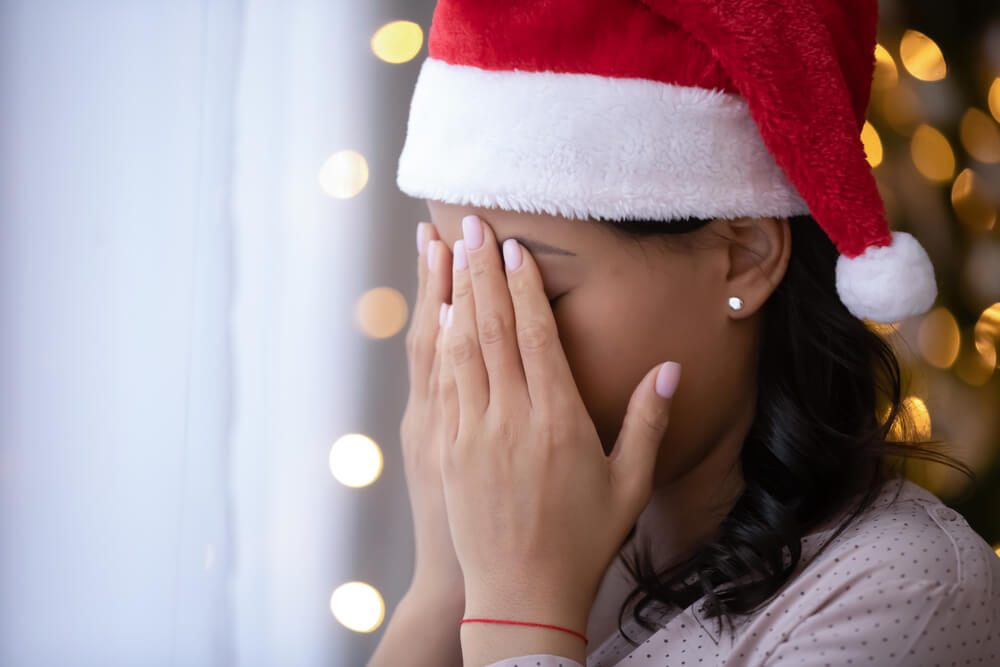
Stress can be behind eye twitching,8 there’s some research linking it to dry eye and some eye doctors think there’s a link between stress and styes, the small red, painful lumps that can appear on your eyelid.30 There are even hints that stress and anxiety can cause blurry vision,31 so no matter how busy you are, try to make time for some me time at Christmas time.
Does Santa have eye problems too?
While we can’t be sure how good Santa’s eyes are, his glasses are a clue that he needs some help to see.
Perhaps they’re reading glasses, which he wears to read the letters and emails he gets from boys and girls all over the world. It’s natural for our eyes to start to struggle to focus on things up close as we get older – the medical name for is presbyopia.32 If Santa does have presbyopia, his specs will come in handy when wrapping presents, too. Or do his elves do that?
Santa’s red cheeks might also be a giveaway. Rosy cheeks are a sign of rosacea, that’s a skin condition that raises the risk of blepharitis.33,34 Look closely at his eyes, if you get the chance. Are his eyelids red and swollen? Maybe his eyelashes are a bit crusty and the skin around his eyes is a bit flaky? These are all signs of blepharitis.35
Lack of sleep may also be taking its toll on Santa’s eyes. Not just the all-nighter he pulls on Christmas Eve but all the late nights beforehand when he is making presents, practising squeezing down chimneys and doing any last-minute repairs on his sleigh. Not getting enough sleep can make eyes red and bloodshot and puffy and sore.36
Then, there’s dry eye. Symptoms, such as soreness, itchiness and redness9 can be made worse by the cold37 – something there’s plenty of at the North Pole.
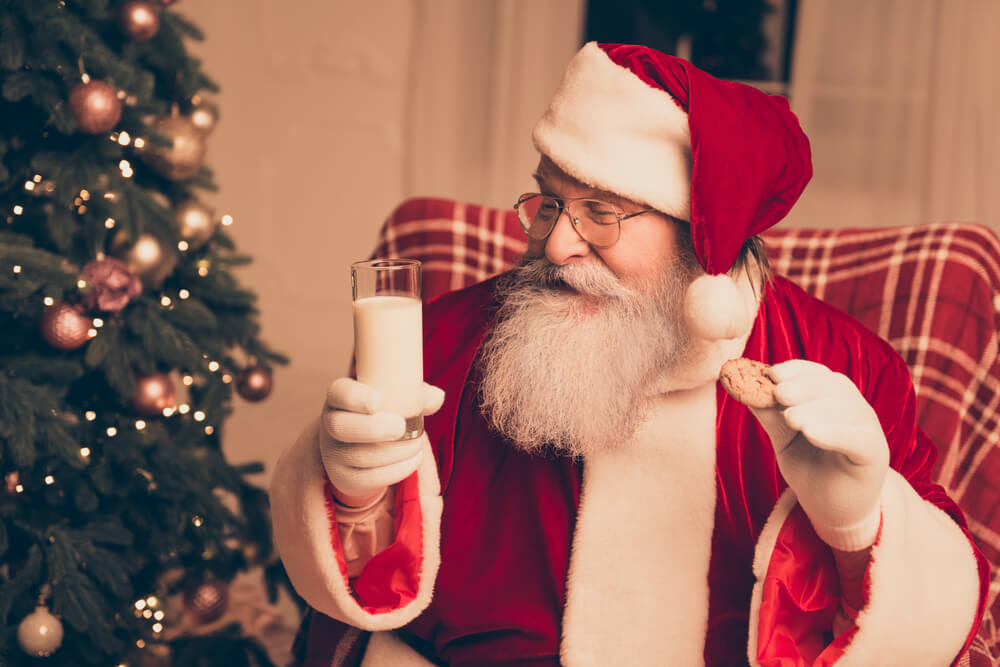
There are some bits of Santa’s job, though, that could be good for his eyes. Just think of all the glasses of eye healthy vitamin A-rich milk38 that are left out for him on Christmas Eve.
And while Rudolph’s carrots (perhaps Santa has a nibble on them when
all the mince pies get too much) won’t give him the power to see in the dark39 (he’ll have to feel his way down all those chimneys!), they are good for his eyes.40


